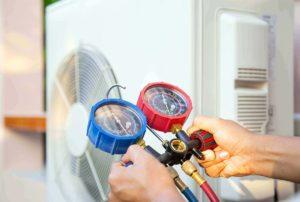An Lowcounty tech explains
Let’s say you’re mowing the lawn or pulling weeds. You’re looking forward to finishing up your chores so you can head inside and enjoy a nice, cool beverage in your nice, cool home. As you’re working, you glance over at your trusty AC unit, and something looks unusual. And by unusual what we mean is frozen.
Alarm bells go off in your head. Oh. That can’t be good.
You’re right. It’s not good when your AC unit freezes up. But don’t panic! If you see any frosty bits on the refrigerant line (or anywhere else, for that matter), there’s plenty you can do on your own before you call us.
Step 1: Thaw your unit
Turn OFF your AC, turn the fan setting to ON, and wait three of four hours. We know, we know: Turning off your AC when it’s sweltering isn’t anyone’s idea of fun. But neither is causing massive (expensive) damage to your AC system, right? So give the poor thing a chance to thaw out.
Step 2: Learn some quick HVAC anatomy
When your refrigerant line is frozen, your indoor evaporator coil is probably also frozen.
The evaporator coil holds refrigerant, which is a liquid or gas that absorbs heat from warm air. (That’s right; AC units don’t really add cold to air; they actually remove heat!) If the refrigerant gets too cold, the moisture in the surrounding air freezes.
So, why would refrigerant get too cold? One of two reasons: low airflow over the coils or low amounts of refrigerant. (Spoiler alert: These are the two things you’re going to check in a bit.)
Step 3: Review the don’ts
Damage to your HVAC system is costly and time-consuming. So as you’re going about your DIY business, make sure you avoid the following:
- Don’t continue to operate your AC. Leaving your unit on despite the freeze-up may burn out the compressor and motor, which can lead to replacing the entire system.
- Don’t scrape or pick off the ice. You’re more likely to damage your equipment. Allow it to thaw completely and naturally.
- Don’t replace refrigerant yourself. We’ll say more about that in a bit.
Step 4: Check for blockages
When it comes to frozen refrigerant lines, the best-case scenario is you have a blockage somewhere. Here are the places to check:
- Air filters. Inspect your air filters and replace them if there’s any visible dirt. Check and replace as needed, at least once a month.
- Supply vents. Open all supply vents the vents that blow air out. Yes, even in the rooms you don’t use.
- Return vents. Unblock any return vents the vents that suck air in. These are most often blocked by furniture or curtains.
- Dirty coils. Blockages can also happen on the evaporator coils themselves. If you’re mechanically inclined, you can carefully clean them yourself with compressed air, a brush, or mild detergent and water. Check your owner’s manual for details.
Step 5: Check your refrigerant
Despite conventional wisdom, refrigerant doesn’t get used up. That means if you’re low on refrigerant, you have a leak.
Ice on your refrigerant line is the #1 sign of a leak, but here are some others to pay attention to:
- Higher-than-normal energy bills
- Air coming out of your vents isn’t very cold
- Bubbling or hissing noises from your HVAC unit
If you suspect a refrigerant leak, do not attempt to replace it yourself. It’s a toxic chemical that should be handled by Lowcounty’s HVAC pros to protect your safety.
Step 6: Give us a call!
If your AC is acting up and none of these quick fixes did the trick, we’re happy to help diagnose, treat, and prevent future problems. Give us a call today!
NEED HELP? CALL NOW!
(843) 605-9905
Tagged hvac

